The Woodland Edge Garden
** Please note: this article is written for the Northern hemisphere. Where we talk about north and south facing gardens everything will be the other way around in the Southern hemisphere.
The woodland garden is potentially the most productive approach for growing food, while requiring far less work to maintain than a conventional system, and also providing wildlife habitats. (For more information see the section ‘Why Perennials’). However, many people do not see this as a suitable system for their garden, voicing objections such as “My garden is much too small” or “I need a lawn for the children to play on” or “It would make my garden much too shady”. This chapter is going to look at ways of addressing such issues.
It is a well established fact that the most productive areas of a woodland are along its edges where higher light levels allow a greater diversity of plant growth. Indeed there is often very little growth at ground level in the depths of the woodland, where the canopy of tall trees prevents much of the light from penetrating to the lower levels. Since it is possible to grow a wide range of food plants on a woodland edge, where space is restricted why not have only the edge? There is absolutely no reason not to do this and, if you site it correctly, it will cast very little, if any, shade into the rest of the garden.
At a squeeze, it is possible to set up this woodland edge in a bed just 1 metre wide, though it would be better to make it at least 1.5 metres wide and if more space was available then the range of plants could be increased significantly. The ideal position would be a strip along the northern edge (southern edge in the Southern hemisphere) of the garden since it would then face towards the south and gain the maximum amount of sunshine. Such a position would also cast virtually no shade into the garden - only in the early mornings and evenings during the summer months would there be any shade at all. The next best position would be the easterly to north-easterly side of the garden. Whilst this would cast shade into the garden in the morning, it would also benefit from the warmer sun of the afternoon and provide some extra frost protection from the early morning sun for the more tender plants. The western side of the garden is not so useful, since it will cast shade into the garden in the afternoon and will miss out on the sunshine in the warmer part of the day. The southern side of the garden is the least useful since it will receive very little direct sunlight and will cast its shade into the garden for much of the day. When siting your garden, do not forget that it might be casting its shade into the neighbouring garden, so either choose plants that do not cast an excessive shade or discuss your plants with any affected neighbours.
It is best if the boundary at the back of the bed is made up of a wall or a fence. This will have an added advantage of providing a support for some of the climbing plants. If, instead, the boundary is made up of a hedge, then there are a number of factors to take into account. Firstly, if the hedge is not shade tolerant, then it will deteriorate rapidly as the woodland edge garden matures. Secondly, if the hedge is shade tolerant, then space will be needed between the hedge and the bed to allow access for trimming since, if left untrimmed, the hedge will grow into the bed and possibly cause problems.
When planning out a woodland edge garden, it is important to arrange the planting so that there is a general increase in height from the front to the back of the border. This will allow the maximum of sunlight to reach all the plants - do not be too purist about this however since it is possible to site some of the smaller more shade-loving plants amongst the taller sun-worshippers. Also, since this is a woodland edge garden, you can follow the basic rule of layers in order to gain maximum food production. These layers are as follows:
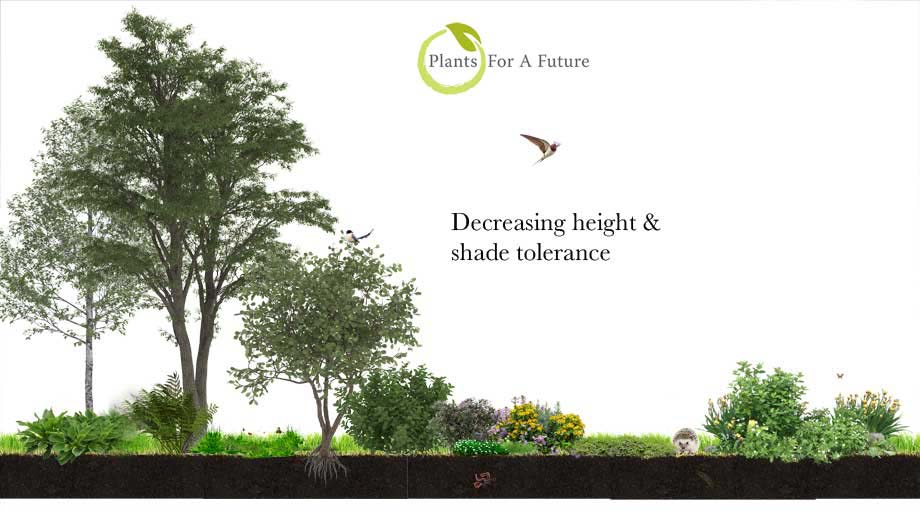
The Canopy
In the narrow border proposed, you could plant one canopy tree for about every 5 metres of the border. Since this is a woodland edge, you would not generally choose the taller canopy trees, restricting yourself to the sun-loving smaller woodland trees. It is not absolutely essential to plant these trees towards the back of the border, especially if you prune them to ensure that there is a clear trunk of 1.5 metres or more, since there will be plenty of side light for the plants growing beneath them. Indeed, the nearer to the back of the border these trees are, then the more of their crop you are likely to lose to your neighbour’s garden (unless you can come to an agreement with them to allow you to harvest from their garden). There are a number of well-known fruit trees that can be used in this layer: pears, apples, plums, cherries and mulberries. There is already plenty of literature available on these plants so they are not dealt with in any more detail here - but do ensure that you don't use plants that have been grafted onto dwarfing rootstocks since they will not grow large enough to form a canopy.
For the canopy you may also consider some other species:
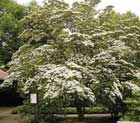 Cornus kousa. The Japanese Dogwood, is a deciduous tree that can grow up to 10 metres tall. It ripens its fruit in late summer; these are the size of very large strawberries and have a succulent flesh with an exquisite flavour. The skin is fairly soft and can be eaten with the fruit, but it does have a decidedly bitter flavour. Perhaps the best approach is to bite a small hole in the skin and then suck out the flesh. It is really like a luscious tropical fruit. The form most often found in gardens is C. kousa chinensis, this is said to grow and fruit better than the species, though there may not be much difference.
Cornus kousa. The Japanese Dogwood, is a deciduous tree that can grow up to 10 metres tall. It ripens its fruit in late summer; these are the size of very large strawberries and have a succulent flesh with an exquisite flavour. The skin is fairly soft and can be eaten with the fruit, but it does have a decidedly bitter flavour. Perhaps the best approach is to bite a small hole in the skin and then suck out the flesh. It is really like a luscious tropical fruit. The form most often found in gardens is C. kousa chinensis, this is said to grow and fruit better than the species, though there may not be much difference.
10m (32ft) by 6m (19ft)
 Crataegus species. This fruiting genus is strangely neglected, with several species producing delicious cherry-sized fruits in the autumn. There is a section ‘Crataegus species -the Hawthorns’ that deals exclusively with these plants on the website, so it is not covered in detail here.
Crataegus species. This fruiting genus is strangely neglected, with several species producing delicious cherry-sized fruits in the autumn. There is a section ‘Crataegus species -the Hawthorns’ that deals exclusively with these plants on the website, so it is not covered in detail here.
The following species are some of the most productive and tasty:
- C. arnoldiana. A tree to 7 metres tall, the fruit is juicy and sweet.
- C. douglasii. Growing up to 9 metres tall, the fruit is similar to C. arnoldiana.
- C. ellwangeriana. Up to 6 metres tall, with very similar fruit to C. arnoldiana.
- C. festiva. Growing 3 - 4 metres tall, the fruit is one of the best in the genus.
- C. pedicellata. Growing up to 7 metres tall, this is one of the latest to ripen - we have eaten its fruits as late as November.
- C. pensylvanica. A tall and wide shrub to 9 metres tall, it has the largest and tastiest fruits that I have yet seen in the genus. It generally produces very heavy crops.
- C. schraderiana. A tree to 6 metres tall, this is one of my favourite fruits. When fully ripe it almost literally melts in the mouth.
- C. tanacetifolia. Growing up to 10 metres tall, the fruit is yellow in colour and rather like an apple in flavour.
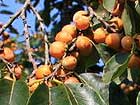 Diospyros lotus and D. virginiana. Ken Fern thought that these two trees produce some of the most delicious fruits he had eaten from plants growing in Britain. They are related to the Persimmon or Sharon Fruit (Diospyros kaki) sometimes seen in greengrocers, and are very similar in shape but smaller, ranging in size from a large cherry to a small crab apple. Only eat the fruit when it is absolutely ripe and squidgy soft, otherwise it will be astringent and have a rather unpleasant effect on your mouth. Fully ripe they taste like a rich apricot jelly. Plants do require a good summer in order to ripen the fruit properly so they grow better in the warmer areas. The fruit also improves after a frost, so allow the fruit to fall naturally from the tree and leave it on the ground (if the birds etc don’t start eating it) until there is a frost or two. Then harvest the fruit and store it in a cool place until it is really soft, in fact almost at the point of going rotten. D. lotus is sometimes called the Date Plum and can grow to about 9 metres tall, D. virginiana is the American Persimmon and can be much taller; it is a good cropper and possibly the best flavoured. Named forms of this plant are available in America.
Diospyros lotus and D. virginiana. Ken Fern thought that these two trees produce some of the most delicious fruits he had eaten from plants growing in Britain. They are related to the Persimmon or Sharon Fruit (Diospyros kaki) sometimes seen in greengrocers, and are very similar in shape but smaller, ranging in size from a large cherry to a small crab apple. Only eat the fruit when it is absolutely ripe and squidgy soft, otherwise it will be astringent and have a rather unpleasant effect on your mouth. Fully ripe they taste like a rich apricot jelly. Plants do require a good summer in order to ripen the fruit properly so they grow better in the warmer areas. The fruit also improves after a frost, so allow the fruit to fall naturally from the tree and leave it on the ground (if the birds etc don’t start eating it) until there is a frost or two. Then harvest the fruit and store it in a cool place until it is really soft, in fact almost at the point of going rotten. D. lotus is sometimes called the Date Plum and can grow to about 9 metres tall, D. virginiana is the American Persimmon and can be much taller; it is a good cropper and possibly the best flavoured. Named forms of this plant are available in America.
10 - 20m
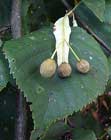 Tilia x europaea. The British native lime trees possibly have the best tasting leaves from a tree. They can be used in salads, replacing lettuces, which can be difficult to grow. Only the young leaves should be used, though these can be produced from spring to autumn from the sucker growth that is often found at the base of the trees. T. cordata and T. platyphyllos are other British natives and can also be used.
Tilia x europaea. The British native lime trees possibly have the best tasting leaves from a tree. They can be used in salads, replacing lettuces, which can be difficult to grow. Only the young leaves should be used, though these can be produced from spring to autumn from the sucker growth that is often found at the base of the trees. T. cordata and T. platyphyllos are other British natives and can also be used.
Whilst the species can grow very tall, there are a number of smaller-growing cultivars available from garden centres and nurseries. 35m (114ft) by 15m (49ft)
The Shrub Layer.
Growing under the canopy trees, this layer can include both sun-loving and shade-tolerant plants since, assuming the woodland garden is oriented as suggested above, the canopy trees will cast very little shade on the bed. As with the canopy layer, there are several well known food plants that can be profitably included in either full sun or dappled shade in this layer. These include blackcurrants, red and white currants, gooseberries, jostaberries, worcesterberries, blueberries, blackberries, raspberries and loganberries. In addition, there are a number of shrubby herbs such as rosemary, sage and rue that will thrive in the sunnier parts of this garden.
 Abutilon vitifolium. A semi-evergreen shrub that can grow up to 8 metres high and 5 metres wide, though it is usually rather smaller in cultivation. It is not hardy in all parts of the country, tolerating temperatures down to about -5 to -10°c, and will appreciate dappled shade. The plant is at its most spectacular in mid to late spring when it is literally covered with lilac or white flowers 5cm or more in diameter - indeed it flowers so freely that it tends to exhaust itself and die after a few years. Fortunately it sets seed freely and grows very quickly from seed, so replacements are easy to provide. The flowers have a pleasant mild flavour and make an excellent addition to the salad bowl.
Abutilon vitifolium. A semi-evergreen shrub that can grow up to 8 metres high and 5 metres wide, though it is usually rather smaller in cultivation. It is not hardy in all parts of the country, tolerating temperatures down to about -5 to -10°c, and will appreciate dappled shade. The plant is at its most spectacular in mid to late spring when it is literally covered with lilac or white flowers 5cm or more in diameter - indeed it flowers so freely that it tends to exhaust itself and die after a few years. Fortunately it sets seed freely and grows very quickly from seed, so replacements are easy to provide. The flowers have a pleasant mild flavour and make an excellent addition to the salad bowl.
8m (26ft) by 5m (16ft)
 Amelanchier species. This is one of our favourite mid-summer fruits. Although called Juneberries, the fruit actually ripens around the middle of July. This fruit is a bit smaller than blackcurrants, is sweet and juicy and has a definite flavour of apples. The main problem with this plant is that it is also a favourite fruit of the birds and so there is a bit of a race as to who gets there first. If you want to eat the fully ripe fruit then you will probably have to use some netting or other protective device.
Amelanchier species. This is one of our favourite mid-summer fruits. Although called Juneberries, the fruit actually ripens around the middle of July. This fruit is a bit smaller than blackcurrants, is sweet and juicy and has a definite flavour of apples. The main problem with this plant is that it is also a favourite fruit of the birds and so there is a bit of a race as to who gets there first. If you want to eat the fully ripe fruit then you will probably have to use some netting or other protective device.
There are many species to choose from, favourites include:
- A. alnifolia. This is a shrub that rarely grows more than 2 - 3 metres tall in this country and so is relatively easy to protect from the birds. It produces the sweetest and juiciest juneberries that I have eaten. Once established, this plant will often produce suckers and can in time form thickets.
- A. lamarckii grows up to 6 metres tall.
- A. stolonifera. This is a relatively low-growing shrub, often no more than 2 metres tall. It can sucker quite freely, though only forms a slowly expanding clump. A very tasty fruit, vying with A. alnifolia as my favourite in the genus.
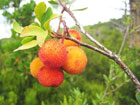 Arbutus unedo. The Strawberry Tree is a delightful evergreen for the garden. Whilst the species can grow up to 9 metres tall, there are cultivars such as ‘Compacta’, ‘Elfin King’ or ‘Rubra’ that rarely go above 2 metres. The plant produces beautiful lily-of-the-valley type flowers in late autumn and is particularly eye-catching at this time since it is also ripening the fruit from the previous year’s flowering. These fruits do look rather like a strawberry, especially from a distance, but unfortunately do not taste like strawberries. Indeed, many people find them quite bland and the Latin name ‘unedo’ means ‘I eat one [only]’ suggesting that they are not a worthwhile food.
Arbutus unedo. The Strawberry Tree is a delightful evergreen for the garden. Whilst the species can grow up to 9 metres tall, there are cultivars such as ‘Compacta’, ‘Elfin King’ or ‘Rubra’ that rarely go above 2 metres. The plant produces beautiful lily-of-the-valley type flowers in late autumn and is particularly eye-catching at this time since it is also ripening the fruit from the previous year’s flowering. These fruits do look rather like a strawberry, especially from a distance, but unfortunately do not taste like strawberries. Indeed, many people find them quite bland and the Latin name ‘unedo’ means ‘I eat one [only]’ suggesting that they are not a worthwhile food.
However, they can be sweet and tasty, though they do have a rather gritty texture. But when you are getting a succulent fruit in winter you can forgive it a little grittiness. This plant does not do well in the colder parts of the country. It is surprisingly wind-tolerant, however, and grows well near the coast.
9m (29ft) by 8m (26ft)
 Atriplex halimus. The Salt Bush is an evergreen shrub growing about 1.5 metres tall and wide. It requires a very sunny position in a well-drained soil and makes a good hedge. The plant is very wind resistant and is tolerant of very salty soils and also of dry conditions. It makes an excellent shelter hedge in maritime areas. It is not cold-hardy in all areas, being defoliated if temperatures drop much below -5°c for any period of time, and often being killed at temperatures much below -10°c.
Atriplex halimus. The Salt Bush is an evergreen shrub growing about 1.5 metres tall and wide. It requires a very sunny position in a well-drained soil and makes a good hedge. The plant is very wind resistant and is tolerant of very salty soils and also of dry conditions. It makes an excellent shelter hedge in maritime areas. It is not cold-hardy in all areas, being defoliated if temperatures drop much below -5°c for any period of time, and often being killed at temperatures much below -10°c.
Instead of spending all your time trimming hedges, grow this plant and trim it by harvesting the young growth for use in salads and as a spinach substitute. The leaves have a distinctive salty taste. It produces very little growth in the winter and so harvesting at this time of the year has to be very moderate. The plant soon bursts into vigorous growth with the warmer spring weather and can then be harvested in quantity. When picking the leaves, do not strip them from the stems but instead pick the whole stem. Harvest just the top 3 - 5cm if using them in salads, but harvest young shoots up to 25cm long if cooking them. When lightly steamed, the leaves retain their flavour and texture well, making an excellent spinach substitute.
2m (6ft) by 3m (9ft)
 Brassica oleracea. This species includes some of our most common vegetables such as cabbage, cauliflower and Brussels sprouts. Whilst these plants are biennial, there are also a few perennial forms. Although not widely known, these perennials can be amongst the most productive food plants that can be grown in the garden. They all grow best in a sunny position and succeed in most soils, doing well in heavy clays. They do not like very acid conditions.
Brassica oleracea. This species includes some of our most common vegetables such as cabbage, cauliflower and Brussels sprouts. Whilst these plants are biennial, there are also a few perennial forms. Although not widely known, these perennials can be amongst the most productive food plants that can be grown in the garden. They all grow best in a sunny position and succeed in most soils, doing well in heavy clays. They do not like very acid conditions.
The true wild form of B. oleracea is the wild cabbage, which can still be found growing by the sea in many parts of the country. A short-lived evergreen perennial, it can grow up to 1.2 metres tall. The leaves have a stronger flavour than the cultivated cabbages, and at times can have a distinct bitterness, especially in the winter. However, it can be a very acceptable cooked vegetable. Plants will usually live for 3 - 5 years, though some have lasted for 10 years or more - they do, however, become rather straggly as they age.
Whilst most of the plants developed from the wild cabbage have lost the ability to be perennial, there are just a few forms where the perennial tendency has been increased. The Tree Collards grows about 2 metres tall and wide, living for up to 20 years. It has mild flavoured dark green leaves that are wrinkled and look rather like savoy cabbage leaves, though the plant does not form a heart. You harvest the young shoots when 5 - 25cm long and cook them stem and all. They are an excellent cabbage substitute. A variety of kale called ‘Daubenton’ is another very good perennial form. About the same size as the preceding species, the leaves have a somewhat coarser flavour but make a very acceptable cooked vegetable.
 Chaenomeles species. The dwarf quinces are not the true quince (which is Cydonia oblonga) though the fruits of these deciduous shrubs are so similar in flavour that you would hardly notice the difference. They vary in size from about 60cm to 3 metres and, for best fruit production, should be grown in a sunny position, though they are not really fussy. Harsh and astringent raw, the cooked fruit becomes very aromatic and can be added to other cooked fruit (especially apples) or used to make jams, jellies etc. The three main species to look out for are C. japonica, C. speciosa and their hybrid C. x superba
Chaenomeles species. The dwarf quinces are not the true quince (which is Cydonia oblonga) though the fruits of these deciduous shrubs are so similar in flavour that you would hardly notice the difference. They vary in size from about 60cm to 3 metres and, for best fruit production, should be grown in a sunny position, though they are not really fussy. Harsh and astringent raw, the cooked fruit becomes very aromatic and can be added to other cooked fruit (especially apples) or used to make jams, jellies etc. The three main species to look out for are C. japonica, C. speciosa and their hybrid C. x superba
-there are also lots of cultivars widely available in garden centres.
 Cornus mas. Cornelian Cherry is a deciduous shrub that can reach 5 metres or more in height. It produces yellow flowers in midwinter and is particularly attractive at this time. The fruit ripens in late summer and needs to be fully ripe or it is very astringent. There is quite a degree of variability in size and quality of fruit. There used to be special cultivated varieties, but these may no longer exist. The fruits can get as large as 2cm long and 1.5cm wide.
Cornus mas. Cornelian Cherry is a deciduous shrub that can reach 5 metres or more in height. It produces yellow flowers in midwinter and is particularly attractive at this time. The fruit ripens in late summer and needs to be fully ripe or it is very astringent. There is quite a degree of variability in size and quality of fruit. There used to be special cultivated varieties, but these may no longer exist. The fruits can get as large as 2cm long and 1.5cm wide.
5m (16ft) by 5m (16ft)
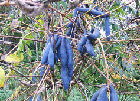 Decaisnea fargesii. A deciduous shrub that can reach 4 metres high and wide, the Blue Sausage Fruit grows best in dappled shade. Whilst it is very cold tolerant when dormant, the young new growth in the spring can be damaged by late frosts and so, if possible, site it in a position that is sheltered from the early morning sun, preferably under the branches of a canopy tree. The fruit, which ripens in the autumn, looks rather like a bright blue sausage or broad bean pod. Peel of the skin and you will find an almost transparent fruit that looks rather like a very large slug - just the thing to put before your most favoured guests! Actually, if you can go beyond its looks, the fruit has a delicate sweetness that is very enjoyable.
Decaisnea fargesii. A deciduous shrub that can reach 4 metres high and wide, the Blue Sausage Fruit grows best in dappled shade. Whilst it is very cold tolerant when dormant, the young new growth in the spring can be damaged by late frosts and so, if possible, site it in a position that is sheltered from the early morning sun, preferably under the branches of a canopy tree. The fruit, which ripens in the autumn, looks rather like a bright blue sausage or broad bean pod. Peel of the skin and you will find an almost transparent fruit that looks rather like a very large slug - just the thing to put before your most favoured guests! Actually, if you can go beyond its looks, the fruit has a delicate sweetness that is very enjoyable.
4m (13ft) by 4m (13ft)
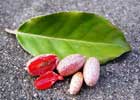 Elaeagnus species. This genus of deciduous and evergreen shrubs produces some of the most nutritious fruits yet discovered in the temperate zone. The deciduous species fruits during the summer; the evergreen species are perhaps the earliest fruiting plants, with their fruit ripening over a 6 -8 week period in early to late spring. They all require a well-drained soil, preferably on the poor side. The deciduous species need a very sunny position whilst the evergreen species require at least some shade and will succeed even in dense shade. The best of the evergreen species are E. x ebbingei and E. cordata. These can grow 4 metres or more tall and wide, though they can be kept much smaller by trimming them in late spring once they have finished fruiting. The fruits, which can be up to 25mm long, need to be fully ripe and squidgy soft otherwise they will make your mouth pucker, but once they are fully ripe they have a lovely rich taste that reminds some people of pineapple. In addition their large seed can also be eaten and is a good source of protein and fats.
Elaeagnus species. This genus of deciduous and evergreen shrubs produces some of the most nutritious fruits yet discovered in the temperate zone. The deciduous species fruits during the summer; the evergreen species are perhaps the earliest fruiting plants, with their fruit ripening over a 6 -8 week period in early to late spring. They all require a well-drained soil, preferably on the poor side. The deciduous species need a very sunny position whilst the evergreen species require at least some shade and will succeed even in dense shade. The best of the evergreen species are E. x ebbingei and E. cordata. These can grow 4 metres or more tall and wide, though they can be kept much smaller by trimming them in late spring once they have finished fruiting. The fruits, which can be up to 25mm long, need to be fully ripe and squidgy soft otherwise they will make your mouth pucker, but once they are fully ripe they have a lovely rich taste that reminds some people of pineapple. In addition their large seed can also be eaten and is a good source of protein and fats.
Of the deciduous species, those particularly recommend are E. multiflora, which grows about 3 metres tall and wide, and produces fruits up to 20mm long in July. E. parvifolia and E. umbellata are two closely related species which can grow up to 4 metres tall. Their fruit, which is produced in late summer and early autumn, is a bit on the small side but is produced in abundance. The fruits of all these three species is slightly astringent, but is generally loved by children, whilst quite a lot of adults also find them very acceptable.. For more information on these plants please see our leaflet ' Elaeagnus x ebbingei - A Plant for all Reasons'.
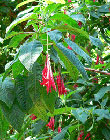 Fuchsia species. Although widely grown in gardens, few people realise that fuchsia fruits are edible and, if the right cultivars or species are chosen, they can make a very acceptable dessert in late summer and early autumn. It is always worth your while tasting the fruits of any fuchsia you see -at the worst you will end up with a peppery after-taste in the mouth and, with the better forms, you will have a delicious fruit. Fuchsias are easily accommodated plants, succeeding in most conditions including heavy clay soils. They are not that hardy, but there are cultivars that will re-sprout from the roots even if the top growth is killed back in the winter. They vary in height and width according to cultivar but are in general less than 1 metre tall. Of those cultivars ‘Globosa’, ‘Tresco’ and ‘Schönbrunner Schuljubiläum’ are recommended for their fruit.
Fuchsia species. Although widely grown in gardens, few people realise that fuchsia fruits are edible and, if the right cultivars or species are chosen, they can make a very acceptable dessert in late summer and early autumn. It is always worth your while tasting the fruits of any fuchsia you see -at the worst you will end up with a peppery after-taste in the mouth and, with the better forms, you will have a delicious fruit. Fuchsias are easily accommodated plants, succeeding in most conditions including heavy clay soils. They are not that hardy, but there are cultivars that will re-sprout from the roots even if the top growth is killed back in the winter. They vary in height and width according to cultivar but are in general less than 1 metre tall. Of those cultivars ‘Globosa’, ‘Tresco’ and ‘Schönbrunner Schuljubiläum’ are recommended for their fruit.
F. splendens produces an exquisite fruit about the size and shape of a baby’s little finger. Unfortunately it can only be grown successfully in the milder parts of the country. F. microphylla is a little hardier, the fruit is round and smaller than currants but produced in reasonable quantities. F. coccinea is hardier still, though it will not succeed in the colder parts of the country. The fruit is about 17mm long and also shaped somewhat like a finger.
 Gaultheria shallon. An evergreen shrub growing up to 1.2 metres high and spreading slowly to form a clump 2 metres or more across, the Shallon requires an acid soil if it is to succeed, and prefers a shady position. Clusters of berries up to 10mm in diameter ripen over a period of 6 weeks in late summer and early autumn. They are juicy and have a pleasant sweet flavour.
Gaultheria shallon. An evergreen shrub growing up to 1.2 metres high and spreading slowly to form a clump 2 metres or more across, the Shallon requires an acid soil if it is to succeed, and prefers a shady position. Clusters of berries up to 10mm in diameter ripen over a period of 6 weeks in late summer and early autumn. They are juicy and have a pleasant sweet flavour.
1.2m (4ft) by 1m (3ft)
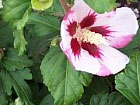 Hibiscus syriacus. The Rose of Sharon is a deciduous shrub that grows up to 3 metres tall and 2 metres wide, though it can be kept smaller by trimming it, and can be grown as a hedge. It prefers a well-drained humus rich fertile soil in a sheltered position in full sun and succeeds in any soil of good or moderate quality. Plants are hardy to about -20°c but plants only really succeed in the warmer counties of Britain because of their late flowering habit. They are also slightly tender when young, and when planted in colder areas of the country they will need protection for the first few winters.
Hibiscus syriacus. The Rose of Sharon is a deciduous shrub that grows up to 3 metres tall and 2 metres wide, though it can be kept smaller by trimming it, and can be grown as a hedge. It prefers a well-drained humus rich fertile soil in a sheltered position in full sun and succeeds in any soil of good or moderate quality. Plants are hardy to about -20°c but plants only really succeed in the warmer counties of Britain because of their late flowering habit. They are also slightly tender when young, and when planted in colder areas of the country they will need protection for the first few winters.
The young leaves can be eaten raw or cooked. They have a very mild, slightly nutty flavour, and though slightly on the tough side they make an acceptable addition to the salad bowl. 3m (9ft) by 2m (6ft)
 Lonicera angustifolia. A deciduous shrub growing to about 2.5 metres tall and 2 metres wide, it requires a very sunny position and prefers growing where the winters are colder and drier, for example the eastern side of Britain. The red fruit is a bit smaller than a blackcurrant, is juicy and has a very pleasant sweet flavour.
Lonicera angustifolia. A deciduous shrub growing to about 2.5 metres tall and 2 metres wide, it requires a very sunny position and prefers growing where the winters are colder and drier, for example the eastern side of Britain. The red fruit is a bit smaller than a blackcurrant, is juicy and has a very pleasant sweet flavour.
2.5 m (9ft)
 Lycium barbarum. The Wolfberry is cultivated as a food crop in China, where the fruits and the young shoots are eaten. A deciduous shrub, it grows about 2.5 metres tall and suckers to form a clump up to 4 metres wide eventually. It grows best in a sunny position, though will tolerate some shade. Fruit production is best if the plant is grown in a fairly poor soil, though a richer soil is best if lots of tender young shoots are required. The fruit, which is often not produced very freely in Britain, can be up to 20mm in diameter and has a mild sweet flavour in which some people detect a hint of liquorice. It should not be eaten until it is fully ripe and can be eaten raw or cooked. When dried, it is much used medicinally in China as a general tonic for the kidneys. It is also said to restore vitality to the hair, preventing premature balding and greying. The young shoots are eaten cooked. They are used mainly as a flavouring, though they can also be lightly cooked for 3 - 4 minutes and used as a vegetable - the flavour is somewhat cress-like but has also been described as like peppermint.
Lycium barbarum. The Wolfberry is cultivated as a food crop in China, where the fruits and the young shoots are eaten. A deciduous shrub, it grows about 2.5 metres tall and suckers to form a clump up to 4 metres wide eventually. It grows best in a sunny position, though will tolerate some shade. Fruit production is best if the plant is grown in a fairly poor soil, though a richer soil is best if lots of tender young shoots are required. The fruit, which is often not produced very freely in Britain, can be up to 20mm in diameter and has a mild sweet flavour in which some people detect a hint of liquorice. It should not be eaten until it is fully ripe and can be eaten raw or cooked. When dried, it is much used medicinally in China as a general tonic for the kidneys. It is also said to restore vitality to the hair, preventing premature balding and greying. The young shoots are eaten cooked. They are used mainly as a flavouring, though they can also be lightly cooked for 3 - 4 minutes and used as a vegetable - the flavour is somewhat cress-like but has also been described as like peppermint.
2.5 m (8ft) by 4 m (13ft)
 Mahonia aquifolium. The Oregon Grape is one of the easiest plants to grow, thriving in almost any soil including heavy clays and dry conditions. An evergreen shrub, it grows about 2 metres tall and suckers to form a clump 1.5 metres or more in diameter. The plant flowers in the winter and early spring, its bright yellow flowers bringing a taste of summer to the garden.
Mahonia aquifolium. The Oregon Grape is one of the easiest plants to grow, thriving in almost any soil including heavy clays and dry conditions. An evergreen shrub, it grows about 2 metres tall and suckers to form a clump 1.5 metres or more in diameter. The plant flowers in the winter and early spring, its bright yellow flowers bringing a taste of summer to the garden.
The fruit ripens in late summer. It is about the size of a blackcurrant and is usually produced in large bunches which makes picking very easy. The flavour is rather on the acid side, which puts some adults off, though children generally love it. It is acceptable in small quantities raw and it also goes very well in muesli or porridge (assuming you like purple porridges!) It does have rather a lot of seeds, however, which can be a pain. There are a number of other Mahonia species that grow well in shady conditions, flowering in the winter and producing their edible fruits in late spring. These include M. japonica, M. bealei and the various cultivars of M. x media including ‘Bucklandii’, ‘Charity’ and ‘Lionel Fortescue’. The fruits are quite juicy and have a pleasant acid flavour when fully ripe. Fruits are sometimes formed without their usual complement of large seeds - whilst this might seem an improvement these fruits are unfortunately quite bitter and unpleasant to eat.
2m (6ft) by 1.5m (5ft)
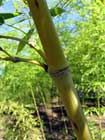 Phyllostachys species. Bamboos add a special quality to a garden, though you will generally need a bed at least 3 metres deep in order to accommodate them properly. While there are several species with a tendency to spread rather aggressively, the members of this genus are generally well-behaved and very stately. Shallow-rooted plants, they grow very well beneath the taller trees, or give them a position in the sun where they will not swamp the smaller trees. All of the species listed below produce edible shoots in the spring and also have quite thick canes that make good plant supports or can be used in craftwork. Young shots for eating are harvested in the spring when they are about 10cm tall and are cut about 5cm below ground level. They generally need to be peeled and are often quite bitter unless they are cooked in at least one change of water. There are many species to choose from in this genus, some of the best for eating include:
Phyllostachys species. Bamboos add a special quality to a garden, though you will generally need a bed at least 3 metres deep in order to accommodate them properly. While there are several species with a tendency to spread rather aggressively, the members of this genus are generally well-behaved and very stately. Shallow-rooted plants, they grow very well beneath the taller trees, or give them a position in the sun where they will not swamp the smaller trees. All of the species listed below produce edible shoots in the spring and also have quite thick canes that make good plant supports or can be used in craftwork. Young shots for eating are harvested in the spring when they are about 10cm tall and are cut about 5cm below ground level. They generally need to be peeled and are often quite bitter unless they are cooked in at least one change of water. There are many species to choose from in this genus, some of the best for eating include:
- Ph. Aurea. The GOLDEN BAMBOO grows up to 6 metres tall and will eventually form a clump 6 metres or more wide. It needs a position in full sun for it to turn the golden colour of its common name The young shoots are amongst the sweetest in the genus and can be eaten raw as well as cooked. The canes are very flexible and are much used in the Orient for making walking sticks, umbrella handles etc.
- Ph. dulcis. The SWEETSHOOT BAMBOO is cultivated as a food crop in China. It can grow up to 5 metres tall and wide and, as the name suggests, the shoots are free of any bitterness.
- Ph. edulis. MOSO-CHIKU is one of the most highly prized edible bamboos in China, growing about 6 metres tall and wide. Its young shoots are probably the largest in the genus and, whilst they are a little bitter, this bitterness is easily removed by changing the water once during cooking. The dormant young shoots, harvested in the winter before they emerge above the ground, are especially relished as a delicacy.
- Ph. nidularia. The BIG-NODE BAMBOO will also reach up to 6 metres tall and wide. The young shoots are highly prized in China both for their earliness and sweet flavour.
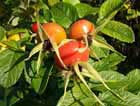 Rosa rugosa. The Ramanas Rose is a fairly common hedge plant in Britain. A fast-growing and vigorously suckering deciduous shrub, it grows up to 2 metres tall. It is very tolerant of maritime exposure and of poor sandy soils. The fruit ripens from mid to late summer, it is deliciously sweet and has a very rich flavour. However, it is rather fiddly to eat, because there is only a fairly thin layer of fruit over a centre comprised of many seeds. It is important not to eat these seeds since they have small hairs on them and these can act as gastric irritants.
Rosa rugosa. The Ramanas Rose is a fairly common hedge plant in Britain. A fast-growing and vigorously suckering deciduous shrub, it grows up to 2 metres tall. It is very tolerant of maritime exposure and of poor sandy soils. The fruit ripens from mid to late summer, it is deliciously sweet and has a very rich flavour. However, it is rather fiddly to eat, because there is only a fairly thin layer of fruit over a centre comprised of many seeds. It is important not to eat these seeds since they have small hairs on them and these can act as gastric irritants.
2 m (6ft) by 2 m (6ft)
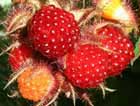 Rubus phoenicolasius. The Japanese Wineberry is a deciduous shrub that can grow up to 3 metres tall. It has biennial stems in the same way as other raspberries, new stems being produced each year that flower in their second year and then die. The orange fruit is about 10mm in diameter and is produced in late summer. It is very juicy and has a raspberry flavour. One useful aspect of this fruit is that the plant very conveniently wraps up each developing fruit in the calyx of the flower, only unwrapping it as the fruit ripens. This does mean that the fruit is almost always maggot-free.
Rubus phoenicolasius. The Japanese Wineberry is a deciduous shrub that can grow up to 3 metres tall. It has biennial stems in the same way as other raspberries, new stems being produced each year that flower in their second year and then die. The orange fruit is about 10mm in diameter and is produced in late summer. It is very juicy and has a raspberry flavour. One useful aspect of this fruit is that the plant very conveniently wraps up each developing fruit in the calyx of the flower, only unwrapping it as the fruit ripens. This does mean that the fruit is almost always maggot-free.
3m (9ft) by 1m (3ft 3in)
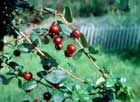 Ugni molinae. You are going to have to live in a very mild area of the country to enjoy the fruit of the Chilean Guava, but it you don’t then it is well worth considering a move just so that you can eat this exquisite fruit. An evergreen shrub, it grows about 2 metres tall and wide, prefers a sunny position though it will also tolerate some shade, and is reasonably wind-resistant. The fruit, which is a bit smaller than a blackcurrant, has a delicious aromatic flavour that has been described as a cross between a wild strawberry and a guava. In fact no words can do justice to this fruit - you have to eat it to believe it.
Ugni molinae. You are going to have to live in a very mild area of the country to enjoy the fruit of the Chilean Guava, but it you don’t then it is well worth considering a move just so that you can eat this exquisite fruit. An evergreen shrub, it grows about 2 metres tall and wide, prefers a sunny position though it will also tolerate some shade, and is reasonably wind-resistant. The fruit, which is a bit smaller than a blackcurrant, has a delicious aromatic flavour that has been described as a cross between a wild strawberry and a guava. In fact no words can do justice to this fruit - you have to eat it to believe it.
2m (6ft) by 1m (3ft)
The Herbaceous Layer
This layer is generally lower than the shrubs, growing both around and under them. It is made up of perennial plants that do not form a woody framework, though some of them are evergreen, and includes both sun-loving and shade-tolerant species. There are a lot of annual and biennial species that could also be grown here, including many of the conventional vegetables such as beetroots, broad beans and lettuces. Several of the more vigorous herbaceous herbs, such as the mints, lemon balm, horseradish and oregano will also grow very well in temperate climates
 Bunias orientalis. Turkish Rocket grows into a clump about 75cm tall and wide. It is a very easily grown plant, succeeding in most soils and preferring a sunny position, though it can also grow well in the light shade of a woodland garden. The plants are also tolerant of considerable neglect and, once established, will grow quite well even in long grass. The young leaves have a mild flavour that is a cross between cabbage and radish. They go very well in a mixed salad and when cooked make an excellent vegetable. They are available early in the year, usually towards the end of winter, and the plant will continue to produce leaves until late autumn, with a bit of a gap when the plant is in flower.
Bunias orientalis. Turkish Rocket grows into a clump about 75cm tall and wide. It is a very easily grown plant, succeeding in most soils and preferring a sunny position, though it can also grow well in the light shade of a woodland garden. The plants are also tolerant of considerable neglect and, once established, will grow quite well even in long grass. The young leaves have a mild flavour that is a cross between cabbage and radish. They go very well in a mixed salad and when cooked make an excellent vegetable. They are available early in the year, usually towards the end of winter, and the plant will continue to produce leaves until late autumn, with a bit of a gap when the plant is in flower.
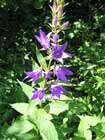 Campanula species. This is a very large genus that contains some very desirable ornamental plants. They are in general fairly easy to grow, most of them preferring a position in full sun and all of them requiring a well-drained soil. They are little bothered by pests and diseases, though slugs adore the leaves and can totally decimate the plants in wet weather. All members of this genus have more or less edible leaves, and some of them have such nice tasting leaves that it is surprising they are not better known. In addition, they also produce beautiful and very tasty flowers that really enhance both the appearance and flavour of a salad. A few favourites are mentioned here, though feel free to try any other species you might be growing since none of them are poisonous.
Campanula species. This is a very large genus that contains some very desirable ornamental plants. They are in general fairly easy to grow, most of them preferring a position in full sun and all of them requiring a well-drained soil. They are little bothered by pests and diseases, though slugs adore the leaves and can totally decimate the plants in wet weather. All members of this genus have more or less edible leaves, and some of them have such nice tasting leaves that it is surprising they are not better known. In addition, they also produce beautiful and very tasty flowers that really enhance both the appearance and flavour of a salad. A few favourites are mentioned here, though feel free to try any other species you might be growing since none of them are poisonous.
C. punctata. The CHINESE RAMPION grows about 35cm tall, spreading to form a clump 75cm or more wide. Flowering in mid summer, this very attractive plant has a reputation for being difficult in some gardens whilst it can also be quite invasive in others. It can succeed in full sun or dappled shade and will probably do best in a light, well drained soil. Both the flowers and the leaves have a pleasantly sweet flavour.
- C. takesimana. The Korean bellflower grows about 50cm tall and spreads rapidly at the roots. It can become invasive, but is easily controlled by hoeing and eating. The leaves and leaf stems of this plant have a very similar flavour to iceberg lettuce whilst the flowers, which are produced in mid summer, have a mild sweet flavour. The leaves are available from early spring until the autumn, though they can become a bit bitter in the summer.
- C. versicolor. Growing up to 1.2 metres tall, this is one of the nicest salad plants I have ever tasted. The leaves have a delicious sweetness that is very similar to fresh garden peas. The plants have a tap root and do not spread. They form a basal rosette of leaves in the winter and can be harvested in moderation in mild winters and then in greater quantities in the spring and summer. Unfortunately, the plant is only hardy in the milder areas of the country and is not very productive of leaves. It is also very susceptible to attacks by slugs. However, if you want to give it a bit of extra care, it will reward you with some very tasty salads and also a superb display of sweet-tasting flowers from mid summer until well into the autumn.
 Chenopodium bonus-henricus. Growing about 30cm tall and wide, Good King Henry grows best in a fertile humus rich soil, though it tolerates considerable neglect and will succeed in most soils and situations. It is said to grow best in a sunny position, though in the summer the leaves will be of a better quality and have a milder flavour if it is grown in light shade. At one time this plant was widely cultivated as a vegetable, but it is seldom grown at present. The young leaves are at their best in the spring and are used as a spinach. The young flowering shoots, harvested when about 12cm long can be peeled and cooked like asparagus - they make a very pleasant spring vegetable. The seed is also edible and can be cooked like rice, though it needs to be soaked first.
Chenopodium bonus-henricus. Growing about 30cm tall and wide, Good King Henry grows best in a fertile humus rich soil, though it tolerates considerable neglect and will succeed in most soils and situations. It is said to grow best in a sunny position, though in the summer the leaves will be of a better quality and have a milder flavour if it is grown in light shade. At one time this plant was widely cultivated as a vegetable, but it is seldom grown at present. The young leaves are at their best in the spring and are used as a spinach. The young flowering shoots, harvested when about 12cm long can be peeled and cooked like asparagus - they make a very pleasant spring vegetable. The seed is also edible and can be cooked like rice, though it needs to be soaked first.
0.3m (1ft) by 0.3m (1ft )
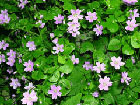 Claytonia sibirica. Miner’s Lettuce is a short-lived annual to perennial plant, but it self-sows so freely that you will never be without it. Growing about 15cm tall, it usually forms a carpet of growth and makes a good ground cover. It prefers a moist peaty soil, though it can succeed on very poor and dry soils and thrives in the shade of trees. The leaves have a fairly bland flavour with a mucilaginous texture, they make a very acceptable salad and are available all year round, even in severe winters.
Claytonia sibirica. Miner’s Lettuce is a short-lived annual to perennial plant, but it self-sows so freely that you will never be without it. Growing about 15cm tall, it usually forms a carpet of growth and makes a good ground cover. It prefers a moist peaty soil, though it can succeed on very poor and dry soils and thrives in the shade of trees. The leaves have a fairly bland flavour with a mucilaginous texture, they make a very acceptable salad and are available all year round, even in severe winters.
C. sibirica is a closely related species. It is more reliably perennial and can even succeed in the dense shade of beech trees. The leaves have a stronger flavour, with a distinct earthy taste of raw beetroot that not everyone likes.
0.2m (0ft 8in)
 Cryptotaenia japonica. Japanese Parsley is not really a parsley, but the leaves taste vaguely like it if you use a considerable amount of imagination. All other parts of the plant can also be eaten, the seeds being used as a flavouring, the stem used as a celery substitute and the root eaten raw or cooked. The plant grows about 45cm tall and prefers a moist shady position under trees, where it will often self-sow. Keep it away from slugs, though, because they will decimate it.
Cryptotaenia japonica. Japanese Parsley is not really a parsley, but the leaves taste vaguely like it if you use a considerable amount of imagination. All other parts of the plant can also be eaten, the seeds being used as a flavouring, the stem used as a celery substitute and the root eaten raw or cooked. The plant grows about 45cm tall and prefers a moist shady position under trees, where it will often self-sow. Keep it away from slugs, though, because they will decimate it.
1m (3ft 3in) by 0.6m (2ft)
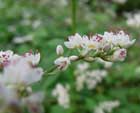 Fagopyrum dibotrys. Perennial Buckwheat is a very vigorous plant for light shade in the woodland. It can grow 2 metres tall and spreads freely when well placed. The leaves can be cooked and eaten like spinach, for which they make an acceptable though not inspiring substitute. The leaves, however, are a good source of rutin and this can have a very beneficial effect on the circulatory system - it is used in the treatment of arteriosclerosis, high blood pressure and rheumatism, for example.
Fagopyrum dibotrys. Perennial Buckwheat is a very vigorous plant for light shade in the woodland. It can grow 2 metres tall and spreads freely when well placed. The leaves can be cooked and eaten like spinach, for which they make an acceptable though not inspiring substitute. The leaves, however, are a good source of rutin and this can have a very beneficial effect on the circulatory system - it is used in the treatment of arteriosclerosis, high blood pressure and rheumatism, for example.
1m (3ft 3in) by 2m (6ft)
 Fragaria vesca 'Semperflorens'. Reaching about 30cm tall and 25cm wide, the Alpine Strawberry will grow and fruit well on the sunnier edges of the woodland garden. Unlike other species of strawberries, this plant does not form runners; this is beneficial in as much as the plants stay where you put them, but has the drawback that you need to sow new seed every 2 - 3 years in order to maintain the vigour of your plants. The fruit is much smaller than the cultivated forms we are more used to, usually around 15mm in diameter. However, the flavour is far superior with a combination of sweet and acid flavours that make this one of the most exquisite fruits that can be grown. The plants start to produce fruit in late spring and crop most heavily in the summer, though they will go on flowering and fruiting right into the autumn.
Fragaria vesca 'Semperflorens'. Reaching about 30cm tall and 25cm wide, the Alpine Strawberry will grow and fruit well on the sunnier edges of the woodland garden. Unlike other species of strawberries, this plant does not form runners; this is beneficial in as much as the plants stay where you put them, but has the drawback that you need to sow new seed every 2 - 3 years in order to maintain the vigour of your plants. The fruit is much smaller than the cultivated forms we are more used to, usually around 15mm in diameter. However, the flavour is far superior with a combination of sweet and acid flavours that make this one of the most exquisite fruits that can be grown. The plants start to produce fruit in late spring and crop most heavily in the summer, though they will go on flowering and fruiting right into the autumn.
0.3 m (1ft) by 0.3 m (1ft in)
 Hemerocallis species. The Day Lilies are very common garden plants, and rightly so, being of very easy cultivation in most soils and situations though preferring at least some sun. The genus is looked at in more detail in the page ‘Hemerocallis Species - The Day Lilies’, and we would heartily recommend you to try growing some of the species for food. A number of species are cultivated in the Orient for their edible flowers, these can be eaten raw or more commonly dried and used as a flavouring in soups. The young shoots in spring can be eaten cooked, though make sure that they are young otherwise they will be very stringy. The root, which has a nutty flavour, can be eaten raw. Any member of this genus can be tried, but H. fulva (especially the variety Kwanso or Green Kwanso), H. middendorfii esculenta and H. multiflora, are recommended.
Hemerocallis species. The Day Lilies are very common garden plants, and rightly so, being of very easy cultivation in most soils and situations though preferring at least some sun. The genus is looked at in more detail in the page ‘Hemerocallis Species - The Day Lilies’, and we would heartily recommend you to try growing some of the species for food. A number of species are cultivated in the Orient for their edible flowers, these can be eaten raw or more commonly dried and used as a flavouring in soups. The young shoots in spring can be eaten cooked, though make sure that they are young otherwise they will be very stringy. The root, which has a nutty flavour, can be eaten raw. Any member of this genus can be tried, but H. fulva (especially the variety Kwanso or Green Kwanso), H. middendorfii esculenta and H. multiflora, are recommended.
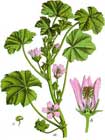 Malva species. All members of this genus have edible leaves and flowers, and all of them make acceptable salad plants. Generally of easy cultivation, they succeed in full sun or light shade and tolerate most soil conditions. Our favourite species include:-
Malva species. All members of this genus have edible leaves and flowers, and all of them make acceptable salad plants. Generally of easy cultivation, they succeed in full sun or light shade and tolerate most soil conditions. Our favourite species include:-
- M. moschata. The MUSK MALLOW grows about 80cm tall and 60cm wide, flowering in early to mid summer and again in the autumn if you cut it down as it comes to the end of its flowering. The plants tend to be short-lived, but they usually self-sow quite freely. This is our main salad plant from late spring until the autumn. The leaves have a pleasant mild flavour and a somewhat mucilaginous texture. This texture is actually of great benefit to the digestive system and can help to soothe digestive disorders - one of the many examples of food also being a medicine. We also eat the flowers, these have a rather bland flavour, but are very ornamental.
- M. alcea. Very similar to the above, requiring the same growing conditions.
- M. sylvestris 'Mauritiana'. This is a cultivar of the common MALLOW and has much larger flowers. This is another plant that tends to be short-lived, so make sure to save the seed and re-sow every year or two. It grows 1 metre or more tall and has rather a straggly habit, so if you like neat plants you might want to give this one some support. The leaves are an excellent salad, with a similar flavour to the plant above, the flowers are even more decorative in salads.
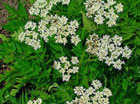 Myrrhis odorata. Sweet Cicely grows up to 1 metre tall and wide. It prefers a moist rich soil in a shady position and grows very well on a woodland edge or lightly dappled shade. The leaves have a delicious sweet aniseed flavour and make an excellent addition to mixed salads. They are also used as a flavouring for vegetables and can be cooked with tart fruits in order to reduce their acidity. The plant produces fresh leaves from late winter until early the following winter.
Myrrhis odorata. Sweet Cicely grows up to 1 metre tall and wide. It prefers a moist rich soil in a shady position and grows very well on a woodland edge or lightly dappled shade. The leaves have a delicious sweet aniseed flavour and make an excellent addition to mixed salads. They are also used as a flavouring for vegetables and can be cooked with tart fruits in order to reduce their acidity. The plant produces fresh leaves from late winter until early the following winter.
0.3m (1ft) by 0.3m (1ft
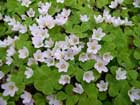 Oxalis acetosella. The British native Wood Sorrel grows about 10cm tall and forms a gradually spreading clump 30cm or more across. It prefers moist shady conditions and a humus-rich soil; it dislikes very heavy and wet soils. Both leaves and flowers have an acid lemon-like flavour which most children love, though many adults also like them. The leaves should not be eaten in quantity, however, because they contain oxalic acid that can prevent us absorbing calcium from our food. Anyone with arthritis or related diseases should also avoid them since they can aggravate the symptoms.
Oxalis acetosella. The British native Wood Sorrel grows about 10cm tall and forms a gradually spreading clump 30cm or more across. It prefers moist shady conditions and a humus-rich soil; it dislikes very heavy and wet soils. Both leaves and flowers have an acid lemon-like flavour which most children love, though many adults also like them. The leaves should not be eaten in quantity, however, because they contain oxalic acid that can prevent us absorbing calcium from our food. Anyone with arthritis or related diseases should also avoid them since they can aggravate the symptoms.
0.3m (1ft) by 0.3m (1ft)
 Rumex acetosa. Sorrel is a very easily grown and tolerant plant that can be up to 50cm tall and 30cm wide. It succeeds in most soils though it prefers a moist moderately fertile well-drained soil in a sunny position. Established plants are tolerant of considerable neglect, surviving and producing tasty leaves even in dense weed growth. They will also grow well in the sunnier areas of a woodland garden. The leaves have a delicious acid flavour, they make a marvellous flavouring in mixed salads and can also be cooked like spinach. You could munch on them when working in the garden, they have a very refreshing effect on the mouth and also relieve thirst. There are some named varieties of this species that have been selected for their larger leaves and reluctance to flower. For example, Ken Fern grew a Polish form that only flowered once in seven years, and produced masses of large leaves, with a small crop of smaller leaves all through the winter.
Rumex acetosa. Sorrel is a very easily grown and tolerant plant that can be up to 50cm tall and 30cm wide. It succeeds in most soils though it prefers a moist moderately fertile well-drained soil in a sunny position. Established plants are tolerant of considerable neglect, surviving and producing tasty leaves even in dense weed growth. They will also grow well in the sunnier areas of a woodland garden. The leaves have a delicious acid flavour, they make a marvellous flavouring in mixed salads and can also be cooked like spinach. You could munch on them when working in the garden, they have a very refreshing effect on the mouth and also relieve thirst. There are some named varieties of this species that have been selected for their larger leaves and reluctance to flower. For example, Ken Fern grew a Polish form that only flowered once in seven years, and produced masses of large leaves, with a small crop of smaller leaves all through the winter.
Bulbs
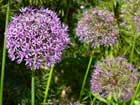 Allium species. Most members of this genus require a sunny position and a well-drained soil. They also tend to be quite intolerant of competition and need to be weeded regularly if they are to thrive. They provide some very tasty flowers, leaves and bulbs, generally with an onion, garlic or leek flavour. Many of them will succeed at the front of the woodland edge garden if you are prepared to give them the extra attention. For information on some of the best of these species please see our leaflet Allium Species - the Perennial Onions. The following species are more tolerant and grow more easily in a woodland garden:-
Allium species. Most members of this genus require a sunny position and a well-drained soil. They also tend to be quite intolerant of competition and need to be weeded regularly if they are to thrive. They provide some very tasty flowers, leaves and bulbs, generally with an onion, garlic or leek flavour. Many of them will succeed at the front of the woodland edge garden if you are prepared to give them the extra attention. For information on some of the best of these species please see our leaflet Allium Species - the Perennial Onions. The following species are more tolerant and grow more easily in a woodland garden:-
- A. ampeloprasum. The WILD LEEK is a native of Britain, growing in hedgerows. The leaves are a bit on the tough side, but the plants come into growth in the autumn and can therefore be harvested in the winter and spring. There are two forms of the wild leek that are probably of more interest to the food grower.
- ELEPHANT GARLIC looks like a gigantic garlic bulb with four huge cloves. It is much milder in flavour than the true garlic, you might be relieved to hear, and makes a nice flavouring in food. The cultivar 'Perizweibel' is grown in Germany for the bulbils it produces instead of flowers. These bulbils are solid rather than made up of layers and are popularly used for making pickles. This cultivar is not currently available in Britain, though we are hoping to secure a supply in the near future.
- A. moly. GOLDEN GARLIC grows about 30cm tall and is often grown in the flower garden. It is probably not hardy in the colder parts of the country, though the dormant bulbs will withstand soil temperatures down to at least -10°c. The bulbs are rather small but are very freely produced and have a pleasant mild garlic flavour. Some forms of this species, especially A. moly bulbiferum, produce bulbils in the flowering head and can be invasive. The species type is sometimes also considered to be invasive, though it has not proved so with most people and in at least one wet garden has proved to be useful for naturalising between shrubs and also grows well at the base of a beech hedge.
- Allium schoenoprasum. CHIVES are a well-known plant that do not really require much information from me. We grow a lot of this plant, plus the more vigorous sub-species A. schoenoprasum sibiricum. These plants provide us with an abundance of leaves from early spring right round to late autumn.
- Allium triquetrum. The THREE-CORNERED LEEK grows about 30cm tall and is naturalised in hedgerows and woodland edges in parts of Britain It provides us with a very good source of edible leaves from October round to April, plus its flowers in the spring and its small bulbs at almost any time of the year. The plant is not hardy in the colder areas of Britain, tolerating temperatures down to about -10°c.
- A. ursinum. Our native WILD GARLIC grows abundantly in hedgerows and woods. It comes into growth in mid to late winter and we use the leaves raw or cooked. They have a very pleasant mild garlic flavour and add a zest to salads at this time of the year. The flowers and small bulbs can also be used. A. triquetrum, the THREE-CORNERED LEEK grows well on the sunnier edges of the woodland. These plants come into growth in the autumn and can supply their leaves throughout the winter.
 Camassia quamash. The QUAMASH grows about 40cm tall and looks a little bit like a bluebell when it flowers in late spring and early sum¬mer. An easily grown plant, it succeeds in most soils and situations and can be grown in grass. The bulb can be eaten raw or cooked, it is a bit gummy raw but has a delicious chestnut-like flavour when cooked. It usually increases quite freely by division, and so there are plenty of spare bulbs for the kitchen.
Camassia quamash. The QUAMASH grows about 40cm tall and looks a little bit like a bluebell when it flowers in late spring and early sum¬mer. An easily grown plant, it succeeds in most soils and situations and can be grown in grass. The bulb can be eaten raw or cooked, it is a bit gummy raw but has a delicious chestnut-like flavour when cooked. It usually increases quite freely by division, and so there are plenty of spare bulbs for the kitchen.
 Erythronium species. The Dog’s Tooth Violets are woodland plants that prefer light soils and some shade, they can also succeed when grown in thin grass. All of them have edible bulbs that have a mild starchy flavour and can be eaten in quantity. Very dainty plants, they grow up to 25cm tall and when well suited to the site can form quite large clumps. Any species can be tried, perhaps the most likely to succeed are the cultivars ‘Pagoda’ and ‘White Beauty’. A word of warning though, the sap from the bulbs can cause dermatitis in some sensitive people.
Erythronium species. The Dog’s Tooth Violets are woodland plants that prefer light soils and some shade, they can also succeed when grown in thin grass. All of them have edible bulbs that have a mild starchy flavour and can be eaten in quantity. Very dainty plants, they grow up to 25cm tall and when well suited to the site can form quite large clumps. Any species can be tried, perhaps the most likely to succeed are the cultivars ‘Pagoda’ and ‘White Beauty’. A word of warning though, the sap from the bulbs can cause dermatitis in some sensitive people.
 Lilium species. Most Lilies have edible bulbs, though often these have a decided bitterness. Possibly the best and the easiest to grow is L. lancifolium, the tiger lily. This grows well in light woodland shade and can reach 1.5 metres tall with a dozen or more large blooms. It is cultivated for its bulb in Japan, where they remove the flowering stem so that the bulb will grow larger. The bulb can be cooked and used like potatoes..
Lilium species. Most Lilies have edible bulbs, though often these have a decided bitterness. Possibly the best and the easiest to grow is L. lancifolium, the tiger lily. This grows well in light woodland shade and can reach 1.5 metres tall with a dozen or more large blooms. It is cultivated for its bulb in Japan, where they remove the flowering stem so that the bulb will grow larger. The bulb can be cooked and used like potatoes..
Ground Cover
These are generally low-growing plants, often very shade tolerant, that can be allowed to spread over the floor of the woodland bed. They are an excellent way of excluding weeds and can also provide a bonus crop. For more details on ground cover plants please see our leaflet Ground Cover Plants.
 Campanula species. This genus has already been mentioned under herbaceous plants. The following species make excellent ground cover.
Campanula species. This genus has already been mentioned under herbaceous plants. The following species make excellent ground cover.
- C. persicifolia. This species grows about 1 metre tall, spreading quite quickly at the roots to form large clumps. It does well in light shade as well as full sun, growing well on a woodland edge. The leaves are rather narrow but have a pleasant slightly sweet flavour. We use them in salads and have not tried cooking them as yet. The flowers, produced for much of the summer, have a lovely sweetness and make a very attractive garnish for salads. The plant is generally evergreen, though in harsh winters it might die back. The sub-species C. persicifolia crystalocalyx has larger leaves than the species and so is more suitable as a food crop.
- C. poscharskyana. The TRAILING BELLFLOWER is a low-growing evergreen plant. About 20cm tall, it spreads rapidly at the roots to form large clumps and therefore makes an excellent ground cover in a sunny position or light shade. Very tolerant of dry conditions, it will even succeed on an old brick wall. The leaves have a slightly sweet flavour, but are a bit on the chewy side. They make an acceptable addition to mixed salads, though we do not like them cooked. Not one of our favourite salads, but they do provide a good source of winter leaves.
- C. portenschlagiana is rather similar to the above and can be used in the same ways.
- C. rapunculoides. The CREEPING BELLFLOWER is a very attractive plant but it has a very aggressive root system and is best used only where you can allow it to romp away - perhaps amongst shrubs that can tolerate the root competition. Growing a metre or so tall, it flowers from mid to late summer. The flowers, leaves and young shoots have a pleasant mild flavour, though the leaves are a little hairy. An added bonus of this genus is that the young roots are edible. These are somewhat sweet with a nut-like flavour and are very palatable, They make a pleasant addition to the salad bowl and can also be cooked as a vegetable.
 Cornus canadensis. The Creeping Dogwood makes an excellent low-growing ground cover. Growing no more than 25cm tall, it spreads quite freely when grown in moist humus-rich soils, preferring acid conditions, and can make clumps a metre or more wide. The plant grows best in light to moderate shade, flowering in late spring to early summer and producing clusters of small red fruits about 6mm in diameter in late summer and early autumn. The fruits are rather dry, a bit gummy and rather mealy but they have a pleasant slightly sweet flavour. They can be added to breakfast cereals or used for making jams, pies, puddings etc. The fruit is particularly high in pectin, a bioflavonoid that has many positive benefits on the circulation and helps to protect the body against radiation damage. Pectin is also used to help jams to set.
Cornus canadensis. The Creeping Dogwood makes an excellent low-growing ground cover. Growing no more than 25cm tall, it spreads quite freely when grown in moist humus-rich soils, preferring acid conditions, and can make clumps a metre or more wide. The plant grows best in light to moderate shade, flowering in late spring to early summer and producing clusters of small red fruits about 6mm in diameter in late summer and early autumn. The fruits are rather dry, a bit gummy and rather mealy but they have a pleasant slightly sweet flavour. They can be added to breakfast cereals or used for making jams, pies, puddings etc. The fruit is particularly high in pectin, a bioflavonoid that has many positive benefits on the circulation and helps to protect the body against radiation damage. Pectin is also used to help jams to set.
Two other closely related species have similar uses, the Dwarf Cornel (Cornus suecica) and the naturally occurring hybrid between these plants the Bunchberry (Cornus x unalaschkensis).
0.3m (1ft) by 1m (3ft)
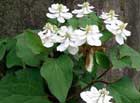 Houttuynia cordata.In a moist, or even a wet soil, the Orange Peel Plant will make a very good ground cover, though in drier soils its growth is too sparse to be effective. Growing about 60cm tall, when conditions permit the plant can spread very freely, forming clumps 1 metre or more wide. The plant produces small flowers in early summer, but the main reason it is grown in gardens is for its ornamental foliage. Several cultivars, such as ‘Chameleon’, have highly variegated green leaves splashed with red, white and yellow. As the common name suggests, the leaves of both the species and its cultivars have a delicious scent reminiscent of orange peel. The plant is cultivated in Vietnam as a flavouring in cooked foods and as a salad plant. It is good as a minor ingredient of mixed salads where it adds a delightful tanginess.
Houttuynia cordata.In a moist, or even a wet soil, the Orange Peel Plant will make a very good ground cover, though in drier soils its growth is too sparse to be effective. Growing about 60cm tall, when conditions permit the plant can spread very freely, forming clumps 1 metre or more wide. The plant produces small flowers in early summer, but the main reason it is grown in gardens is for its ornamental foliage. Several cultivars, such as ‘Chameleon’, have highly variegated green leaves splashed with red, white and yellow. As the common name suggests, the leaves of both the species and its cultivars have a delicious scent reminiscent of orange peel. The plant is cultivated in Vietnam as a flavouring in cooked foods and as a salad plant. It is good as a minor ingredient of mixed salads where it adds a delightful tanginess.
0.6m (2ft) by 1m (3ft)
 Mahonia nervosa and M. repens. This genus has been dealt with in more detail above. These two low-growing species, both known as Creeping Oregon Grape, can thrive in quite dense shade and will slowly form an effective ground cover. Their acid-flavoured fruit is very similar to the Oregon Grape (Mahonia aquifolia).
Mahonia nervosa and M. repens. This genus has been dealt with in more detail above. These two low-growing species, both known as Creeping Oregon Grape, can thrive in quite dense shade and will slowly form an effective ground cover. Their acid-flavoured fruit is very similar to the Oregon Grape (Mahonia aquifolia).
0.6m (2ft) by 1m (3ft 3in) and 0.3m (1ft) by 2m (6ft 7in)
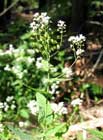 Peltaria alliacea. Garlic Cress is a vigorous spreading plant that grows up to 30cm tall and makes a good ground cover in a sunny position or in light shade. It prefers a light fertile moist soil though it is not too fussy. An evergreen plant, it provides its edible leaves all year round apart for a few weeks in the summer when it is flowering and producing seed. These leaves have a strong garlic/mustard flavour which makes an excellent addition to salads or cooked dishes. They do develop a rather bitter aftertaste in hot dry weather though.
Peltaria alliacea. Garlic Cress is a vigorous spreading plant that grows up to 30cm tall and makes a good ground cover in a sunny position or in light shade. It prefers a light fertile moist soil though it is not too fussy. An evergreen plant, it provides its edible leaves all year round apart for a few weeks in the summer when it is flowering and producing seed. These leaves have a strong garlic/mustard flavour which makes an excellent addition to salads or cooked dishes. They do develop a rather bitter aftertaste in hot dry weather though.
0.3 m (1ft) by 0.3 m (1ft in)
 Rubus nepalensis. The Nepalese Raspberry, is a very low-growing evergreen shrub that makes an excellent ground cover. The plants seldom get taller than 20cm, but instead send out fairly vigorous ground-hugging stems that root at intervals as they scramble across the ground. Although the books say that the plant is only hardy in the milder areas of Britain, it is growing and fruiting at Cambridge Botanic gardens, which gets quite cold winters. The fruit is produced in mid to late summer. It is about two-thirds the size of conventional raspberries and has a very nice acid flavour.
Rubus nepalensis. The Nepalese Raspberry, is a very low-growing evergreen shrub that makes an excellent ground cover. The plants seldom get taller than 20cm, but instead send out fairly vigorous ground-hugging stems that root at intervals as they scramble across the ground. Although the books say that the plant is only hardy in the milder areas of Britain, it is growing and fruiting at Cambridge Botanic gardens, which gets quite cold winters. The fruit is produced in mid to late summer. It is about two-thirds the size of conventional raspberries and has a very nice acid flavour.
0.2m (8in) by 1m (3ft)
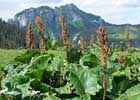 Rumex alpinus. Whilst docks have long been seen as a weed to be eradicated from the garden, the Alpine Dock has a long history of cultivation in Europe as a spinach plant. Growing up to 1 metre tall and slowly spreading to form dense clumps, the plant will succeed in most soils and conditions. The best quality leaves are produced when the plant is grown in dappled shade - in full sun the leaves can become bitter in the summer. The best time to eat the leaves is in early spring, when they are tender with almost no bitterness and are very acceptable raw in mixed salads. The leaves can be harvested for spinach throughout the spring and early summer, then again in the autumn until they finally die down towards the end of the year. In very mild years it is possible to harvest leaves all through the winter.
Rumex alpinus. Whilst docks have long been seen as a weed to be eradicated from the garden, the Alpine Dock has a long history of cultivation in Europe as a spinach plant. Growing up to 1 metre tall and slowly spreading to form dense clumps, the plant will succeed in most soils and conditions. The best quality leaves are produced when the plant is grown in dappled shade - in full sun the leaves can become bitter in the summer. The best time to eat the leaves is in early spring, when they are tender with almost no bitterness and are very acceptable raw in mixed salads. The leaves can be harvested for spinach throughout the spring and early summer, then again in the autumn until they finally die down towards the end of the year. In very mild years it is possible to harvest leaves all through the winter.
1.2m (4ft) by 0.3m (1ft)
 Viola odorata. Sweet Violet is another evergreen native plant. It grows about 15cm tall and spreads quite vigorously to form large clumps. It makes an excellent ground cover. The plant succeeds in most soils but prefers a cool moist well-drained humus-rich soil in partial or dappled shade, and protection from scorching winds. The leaves have a fairly bland flavour with a slightly tough texture. Not the most wonderful of leaves, but quite acceptable as part of a mixed salad. Perhaps the best part of the plant to eat is the flowers. These are produced in late winter and early spring, they have a delicious sweet scent and make a wonderful addition to mixed salads. All other members of this genus have edible leaves and flowers, usually with a very mild flavour. However, it is not a good idea to eat large quantities of any forms with yellow flowers since these have been known to cause stomach upsets.
Viola odorata. Sweet Violet is another evergreen native plant. It grows about 15cm tall and spreads quite vigorously to form large clumps. It makes an excellent ground cover. The plant succeeds in most soils but prefers a cool moist well-drained humus-rich soil in partial or dappled shade, and protection from scorching winds. The leaves have a fairly bland flavour with a slightly tough texture. Not the most wonderful of leaves, but quite acceptable as part of a mixed salad. Perhaps the best part of the plant to eat is the flowers. These are produced in late winter and early spring, they have a delicious sweet scent and make a wonderful addition to mixed salads. All other members of this genus have edible leaves and flowers, usually with a very mild flavour. However, it is not a good idea to eat large quantities of any forms with yellow flowers since these have been known to cause stomach upsets.
0.1m (4in) by 0.5m (1½ ft)
Climbing Plants
There are a number of ways in which climbing plants can be included in this garden. Some of the more shade tolerant can be grown at the back of the border, training them along the fence or wall. Others can be allowed to find their way naturally into the surrounding shrubs and trees. Others can be allowed to scramble along the ground where they will act as a ground cover. In addition to the species mentioned below, some of the more conventional climbing and fruiting plants such as BLACKBERRIES and GRAPES can also be grown here.
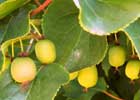 Actinidia species. All members of this genus of deciduous climbing plants produce edible fruits, though they do not all do well in temperate conditions. The best known species is A. deliciosa, the Kiwi Fruit. This is widely sold in British greengrocers, though not many people realize it can be grown there successfully, at least in the warmer parts of the country. If you want fruit that you can pick then you will need to prune the plants to keep them small - if left unpruned they will romp away and can grow to the top of trees 20 metres or more tall!
Actinidia species. All members of this genus of deciduous climbing plants produce edible fruits, though they do not all do well in temperate conditions. The best known species is A. deliciosa, the Kiwi Fruit. This is widely sold in British greengrocers, though not many people realize it can be grown there successfully, at least in the warmer parts of the country. If you want fruit that you can pick then you will need to prune the plants to keep them small - if left unpruned they will romp away and can grow to the top of trees 20 metres or more tall!
There are two main difficulties with this crop. The first is that, although the dormant plants are quite cold hardy, the young shoots in spring are very susceptible to frost damage. It is therefore best to grow them on a westerly aspect so that they are protected from the morning sun but still get plenty of warm sunshine. The second problem is that plants are usually either male or female, so you need to grow at least one male plant for every 4 - 5 females in order to get fruit. There are some cultivars that do not need a male for fertilization, though these are said to have inferior fruits. When grown from seed, the vast majority of seedlings are male, so it is best to buy named varieties. ‘Heywood’ is the female form that is most commonly offered, though others can sometimes be found. ‘Tomuri’ is said to be a good pollinator. Of the other species, probably the best to try in temperate climates is A. arguta, the TARA VINE. This is even hardier than the kiwi, its fruit is rather smaller but not covered with hairs, and so can be eaten without peeling.
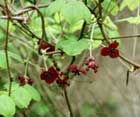 Akebia quinata. The Akebia is quite a vigorous semi-evergreen plant that can climb 12 metres or more, twining into trees and shrubs. It is very amenable to trimming, which is best done in early spring. If it does not find anything to support it then it will scramble over the ground, the branches rooting into the earth and making an acceptable ground cover amongst taller plants. It requires a well-drained moisture retentive soil and will succeed in acid or alkaline conditions. Whilst the dormant plant is hardy to about -20°c, the young growth in spring, even on mature plants, is frost-tender and so it is best to grow the plants in a position sheltered from the early morning sun. The fruit can be 5 - 10cm long and has a delicate flavour and a soft, juicy texture. Unfortunately, is seldom produced in temperate climates, possibly because the plant is self-sterile and only one clone is being grown. Where possible try to obtain two plants from genetically different sources - preferably by growing your own plants from seed, since each seedling will be genetically different from any other seedling. There are two other members of this genus with similar growth habits and uses. These are A. trifoliata and A. x pentaphylla.
Akebia quinata. The Akebia is quite a vigorous semi-evergreen plant that can climb 12 metres or more, twining into trees and shrubs. It is very amenable to trimming, which is best done in early spring. If it does not find anything to support it then it will scramble over the ground, the branches rooting into the earth and making an acceptable ground cover amongst taller plants. It requires a well-drained moisture retentive soil and will succeed in acid or alkaline conditions. Whilst the dormant plant is hardy to about -20°c, the young growth in spring, even on mature plants, is frost-tender and so it is best to grow the plants in a position sheltered from the early morning sun. The fruit can be 5 - 10cm long and has a delicate flavour and a soft, juicy texture. Unfortunately, is seldom produced in temperate climates, possibly because the plant is self-sterile and only one clone is being grown. Where possible try to obtain two plants from genetically different sources - preferably by growing your own plants from seed, since each seedling will be genetically different from any other seedling. There are two other members of this genus with similar growth habits and uses. These are A. trifoliata and A. x pentaphylla.
12m (40ft)
 Apios americana. The GROUND NUT is a herbaceous climbing plant, reaching about 1.2 metres tall. It belongs to the pea and bean family and, like many other members of that family, it helps to enrich the soil with nitrogen by means of bacteria that live on the roots and fix atmospheric nitrogen. The root, which is unusually high in protein, has a very pleasant sweet taste when baked. It can be cooked in many other ways and can also be eaten raw, though it is rather a tough chew. Yields from the wild plant are fairly low, though they are much better if the plant is left in the ground for 2 years before harvesting. There are a number of cultivated forms being developed, however, that have much higher yields and the plant has been recommended for commercial cultivation. This species can be grown along the sunny edges of a woodland garden and either allowed to twine its way into small shrubs or given some supports to climb into.
Apios americana. The GROUND NUT is a herbaceous climbing plant, reaching about 1.2 metres tall. It belongs to the pea and bean family and, like many other members of that family, it helps to enrich the soil with nitrogen by means of bacteria that live on the roots and fix atmospheric nitrogen. The root, which is unusually high in protein, has a very pleasant sweet taste when baked. It can be cooked in many other ways and can also be eaten raw, though it is rather a tough chew. Yields from the wild plant are fairly low, though they are much better if the plant is left in the ground for 2 years before harvesting. There are a number of cultivated forms being developed, however, that have much higher yields and the plant has been recommended for commercial cultivation. This species can be grown along the sunny edges of a woodland garden and either allowed to twine its way into small shrubs or given some supports to climb into.
1.2m (4ft)
 Dioscorea batatas and D. japonica. The hardy Yam is cultivated in Japan as a root crop but, although it grows very well in temperate climates, it has never been popular. A climbing plant reaching 2.4 metres or more in height, it requires a sunny position in a fertile well-drained soil and should be given some support on which to twine. If you have a deep rich soil then the root can be up to 1 metre long and weigh 2 kilos or more. Rich in starch, it is best baked but can also be boiled, added to stews etc. There is no strong flavour, but the overall taste is very acceptable and it can be eaten in quantity as a staple crop. It is reminiscent of a floury potato. You can propagate the plant by cutting off the top few inches of root and replanting this. An easier method is to harvest the small tubercles (baby tubers that look a little like small bulbs) that are formed in the leaf axils along the stems. Collect them in late summer, once they are easily detached from the plant, and pot them up immediately in a cold greenhouse. They will remain dormant in the winter and then come into growth in the spring. Plant them out in the summer when they are in active growth.
Dioscorea batatas and D. japonica. The hardy Yam is cultivated in Japan as a root crop but, although it grows very well in temperate climates, it has never been popular. A climbing plant reaching 2.4 metres or more in height, it requires a sunny position in a fertile well-drained soil and should be given some support on which to twine. If you have a deep rich soil then the root can be up to 1 metre long and weigh 2 kilos or more. Rich in starch, it is best baked but can also be boiled, added to stews etc. There is no strong flavour, but the overall taste is very acceptable and it can be eaten in quantity as a staple crop. It is reminiscent of a floury potato. You can propagate the plant by cutting off the top few inches of root and replanting this. An easier method is to harvest the small tubercles (baby tubers that look a little like small bulbs) that are formed in the leaf axils along the stems. Collect them in late summer, once they are easily detached from the plant, and pot them up immediately in a cold greenhouse. They will remain dormant in the winter and then come into growth in the spring. Plant them out in the summer when they are in active growth.
3m (9ft) by 1.5m (5ft)
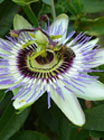 Passiflora caerulea. This is a vigorous evergreen plant that can grow 10 metres or more and supports itself on plants, trellises or strings by means of tendrils. It requires a sunny position if it is to fruit well and prefers a well-drained but moisture-retentive soil. The plant has a very long flowering season, from early to late summer, though individual flowers only last for about 2 days. For best fruit production it is best to find a way of restricting root growth. When ripe, the orange-yellow fruits are about 6cm long and 4cm wide, they are partly hollow and contain only a small amount of a pleasant acid-tasting pulp surrounding a large quantity of seeds.
Passiflora caerulea. This is a vigorous evergreen plant that can grow 10 metres or more and supports itself on plants, trellises or strings by means of tendrils. It requires a sunny position if it is to fruit well and prefers a well-drained but moisture-retentive soil. The plant has a very long flowering season, from early to late summer, though individual flowers only last for about 2 days. For best fruit production it is best to find a way of restricting root growth. When ripe, the orange-yellow fruits are about 6cm long and 4cm wide, they are partly hollow and contain only a small amount of a pleasant acid-tasting pulp surrounding a large quantity of seeds.
10m (32ft) by 10m (32ft)
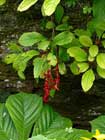 Schisandra grandiflora and Schisandra rubriflora. These rather similar deciduous twining climbers grow about 6 metres tall and produce bunches of small red fruits looking somewhat like small loose bunches of grapes. The fruits are about 8mm in diameter and have a delicious sweet flavour.
Schisandra grandiflora and Schisandra rubriflora. These rather similar deciduous twining climbers grow about 6 metres tall and produce bunches of small red fruits looking somewhat like small loose bunches of grapes. The fruits are about 8mm in diameter and have a delicious sweet flavour.
Grow it in semi-shade in a slightly acid soil, though it will succeed in slightly alkaline soils if lots of organic matter is added.
6m (19ft)
Tropaeolum tuberosum. This is a herbaceous climbing plant that grows very well into small shrubs, or can be grown on a trellis or even left to scramble over the ground. It requires a lime-free soil that does not dry out in the summer and dislikes drought. Whilst the top-growth likes to climb up into the sunlight, the roots prefer to be in a shady position. This plant is not terribly hardy, the top-growth will be killed by anything more than a degree or two of frost and the roots will be damaged by temperatures below -5°c. However, you can harvest the roots in the autumn after the top-growth has died down, storing them in a cool but frost-free place over the winter and replanting them in the spring. In mild areas of the country it is possible to leave the roots in the ground, though it is best to give them a good mulch. 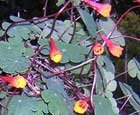 The plant sends out scrambling stems that can be up to 2 metres long, it flowers in late summer and the autumn. Whilst the leaves are edible, they are rather less than delicious. The tubers are the nicest part to eat, though many people would disagree with this. It really is a food that you will either love or hate, for there is a distinct pepperyness to the flavour. The plant is commonly cultivated in S. America as a food crop, they cook the roots and then freeze them before re-heating and eating them. I have not tried this, but have found the roots to be acceptable if they are harvested after being exposed to a few frosts.
The plant sends out scrambling stems that can be up to 2 metres long, it flowers in late summer and the autumn. Whilst the leaves are edible, they are rather less than delicious. The tubers are the nicest part to eat, though many people would disagree with this. It really is a food that you will either love or hate, for there is a distinct pepperyness to the flavour. The plant is commonly cultivated in S. America as a food crop, they cook the roots and then freeze them before re-heating and eating them. I have not tried this, but have found the roots to be acceptable if they are harvested after being exposed to a few frosts.
2m (6ft 7in)

Database
The database has more details on these plants: Abutilon vitifolium, Akebia quinata, Allium schoenoprasum, Allium triquetrum, Apios americana, Arbutus unedo, Atriplex halimus, Brassica oleracea, Bunias orientalis, Camassia quamash, Chenopodium bonus-henricus, Claytonia sibirica, Cornus canadensis, Cornus kousa, Cornus mas, Cornus suecica, Cornus x unalaschkensis, Cryptotaenia japonica, Cydonia oblonga, Decaisnea fargesii, Dioscorea batatas, Diospyros kaki, Diospyros lotus, Elaeagnus x ebbingei, Fagopyrum dibotrys, Fragaria, Fragaria vesca, Fragaria vesca 'Semperflorens', Gaultheria shallon, Hibiscus syriacus, Houttuynia cordata, Lonicera angustifolia, Lycium barbarum, Mahonia aquifolium, Mahonia nervosa, Myrrhis odorata, Oxalis acetosella, Passiflora caerulea, Peltaria alliacea, Rosa rugosa, Rubus nepalensis, Rubus phoenicolasius, Rumex acetosa, Rumex alpinus, Schisandra grandiflora, Schisandra rubriflora, Tilia x europaea, Tropaeolum tuberosum, Ugni molinae, Viola odorata.